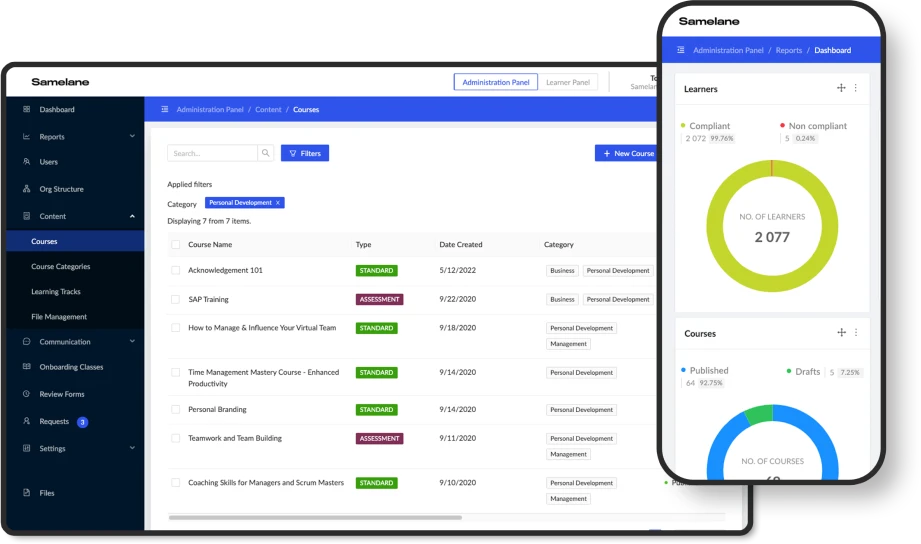Effective training and impactful learning outcomes are crucial to driving organizational success in today’s competitive landscape. However, measuring their effectiveness using relevant learning and development metrics is essential to ensure that training programs deliver the desired results. Through leveraging suitable training metrics, organizations can gain valuable insights into their training strategies’ efficacy, identify improvement areas, and maximize performance. In this article, we delve into the world of training and learning metrics, highlighting the best and most commonly used indicators that enable organizations to evaluate the success of their training initiatives. We also explore how Learning Management Systems (LMS) are crucial in measuring training and learning outcomes, providing a comprehensive and data-driven approach to monitor progress and drive continuous improvement.
What are training metrics?
A training and knowledge metric is a quantifiable measurement used to assess training programs’ effectiveness and impact on knowledge acquisition and retention. These learning and development metrics provide insights into training initiatives’ effectiveness in knowledge transfer, skill development, and overall learning outcomes. By tracking and analyzing training and knowledge metrics, organizations can evaluate their training efforts’ success, identify improvement areas, and make data-driven decisions to enhance learning experiences. By monitoring and analyzing training and knowledge metrics, organizations can assess their training programs’ effectiveness, identify improvement areas, and tailor future training initiatives.
Why measuring training and learning is important?
Measuring training and learning outcomes serves several essential purposes for organizations. Here are some key reasons why they are so vital:
Evaluation of effectiveness: Measuring training and learning outcomes allows to assess the effectiveness of training initiatives. It provides valuable insights into whether the training programs achieve their objectives and deliver the desired results. By evaluating the effectiveness of training, organizations can identify strengths and areas for improvement, enabling them to optimize their training strategies and allocate resources more efficiently.
ROI assessment: Measuring training and learning outcomes helps organizations determine their training programs’ return on investment (ROI). Organizations can evaluate the value generated from their training initiatives by quantifying the impact of training on business outcomes, such as improved productivity, increased sales, or reduced errors. This information is crucial for decision-makers when allocating budgets and resources for future training endeavors.
Continuous improvement: Measuring training and learning outcomes provides a basis for continuous improvement. By identifying gaps or deficiencies in knowledge or skills, organizations can develop targeted interventions and adjust their training programs accordingly. Regular assessment of outcomes allows for iterative improvements, ensuring that training efforts align with evolving business needs and industry trends.
Alignment with organizational goals: Measuring training and learning outcomes helps ensure alignment between the training programs and the overall goals and objectives of the organization. It allows organizations to track progress toward specific performance indicators, competencies, or targets. By aligning training outcomes with organizational goals, organizations can foster a continuous learning and development culture that directly contributes to business success.
Accountability and compliance: Measuring training and learning outcomes is critical in ensuring accountability and compliance with regulatory requirements or industry standards. It provides evidence that necessary training has been completed and that employees possess the knowledge and skills to perform their jobs safely and effectively. This is particularly important in industries with stringent compliance regulations or where employee certifications are necessary.

How to measure training effectiveness: training metrics
Measuring training effectiveness requires using specific metrics that align with the desired learning outcomes and organizational goals. By selecting metrics aligned with the objectives and results of the training program, organizations can evaluate training effectiveness, make data-driven decisions for improvement, and demonstrate the value of training investments. Here is a selection of the most common training metrics:
- Completion rates: This metric measures the percentage of learners who complete a training program, indicating their level of engagement and commitment.
- Knowledge acquisition: Assessing learners’ knowledge acquisition is crucial in measuring training effectiveness. Pre- and post-training assessments or quizzes can be used to evaluate the increase in knowledge and understanding.
- Training feedback: Collecting feedback from learners regarding their satisfaction, perceived usefulness, and relevance of the training provides valuable insights into its effectiveness. Surveys or feedback forms can be used to gather this information.
- Performance improvement: Tracking performance indicators, such as productivity, quality, or customer satisfaction, before and after training helps assess the impact of training on job performance. Comparing performance metrics can indicate the effectiveness of the training program.
- Cost-effectiveness: Evaluating the financial investment in training programs, including expenses related to content creation, delivery platforms, and instructor fees, helps gauge the cost-effectiveness of the training initiatives. This metric considers the financial investment in training compared to the outcomes achieved. It involves analyzing training costs, including development, delivery, and evaluation expenses, against the benefits gained.
- Time to competency: Measuring the time it takes for learners to achieve competency or proficiency in specific skills or tasks can indicate the efficiency and effectiveness of the training program.
- Retention and transfer of learning: Assessing learners’ ability to retain and transfer knowledge and skills to their work environment is critical in measuring the long-term impact of training. Follow-up assessments or on-the-job performance evaluations can help determine the retention and application of learning.
- Return on Investment (ROI): Evaluating the financial return on investment by comparing the training costs to the quantifiable benefits, such as increased revenue, cost savings, or improved efficiency, helps assess the overall effectiveness of the training program.
- Pre and post-assessment scores: Organizations can measure how much knowledge has been acquired and retained by comparing learners’ performance before and after training.
- Key Performance Indicators (KPIs): Monitoring specific metrics related to job performance, such as sales figures or customer satisfaction ratings, helps evaluate the impact of training on actual work outcomes.
- Error Rates: Tracking the frequency of errors or mistakes in job performance provides insights into the effectiveness of training interventions.
- Training Time: Measuring the time required for learners to complete training modules or achieve desired learning outcomes indicates training efficiency. Monitoring learners’ time on training activities also provides insights into their active participation and interest.
Maximize performance through data-driven insights
It is worth highlighting that utilizing the best training and learning metrics is crucial for organizations to gauge their training programs’ effectiveness, identify improvement areas, and drive performance. Leveraging an LMS, like Samelane, to measure and track these metrics provides a comprehensive and efficient approach, enabling organizations to make informed decisions and continuously enhance their training initiatives. By maximizing performance through data-driven insights, organizations can unlock the full potential of their workforce and achieve sustainable success in the ever-evolving business landscape.











